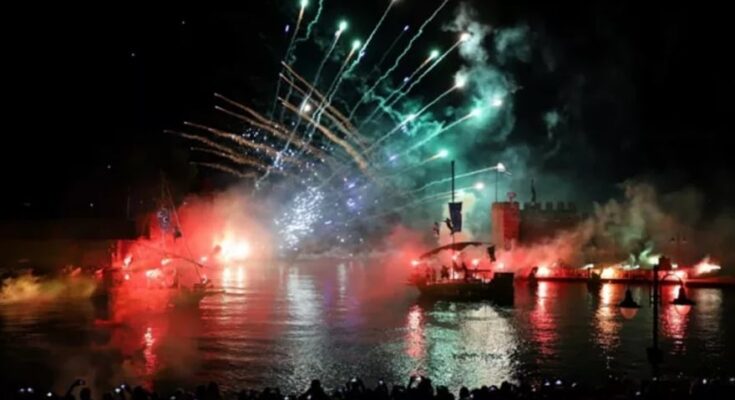
The town of Nafpaktos in western Greece is celebrating the anniversary of the Battle of Lepanto which will include a spectacular display of battling ships and fireworks.
Thousands are expected to turn up at the Venetian harbor to witness a re-enactment of the famous naval engagement that took place on 7 October 1571 where a fleet of the Holy League, led by the Venetian Republic and the Spanish Empire, inflicted a major defeat on the fleet of the Ottoman Empire in the Gulf of Patras.
The Ottoman forces were sailing westward from their naval station in Lepanto (the Venetian name Nafpaktos) when they met the fleet of the Holy League which was sailing east from Messina, Sicily.
In the history of naval warfare, Lepanto marks the last major engagement in the Western world to be fought almost entirely between rowing vessels, namely the galleys and galleasses which were the direct descendants of ancient trireme warships.
The battle was an “infantry battle on floating platforms”. It was the largest naval battle in Western history since classical antiquity, involving more than 400 warships.
It marked the first significant defeat of the Ottoman navy, effectively halting its expansion into the Western Mediterranean. It shattered the myth of Ottoman invincibility on the seas.
The battle altered the balance of power in the Mediterranean. It signaled the decline of Ottoman maritime strength and the rise of European powers like Spain and Venice as dominant forces in the region.
For many Greeks and other Christians who were under Ottoman domination, the victory symbolized hope and resistance against their oppressors. It showed that the Ottoman forces could be defeated, and it rekindled dreams of liberation among those living under Ottoman rule.
Miguel de Cervantes fought in the battle
It also became a powerful symbol in European literature, art, and culture. Writers like Miguel de Cervantes, who fought in the battle, drew upon it in their works, and it became a celebrated event in paintings, poems, and music.
The statue of Miguel de Cervantes stands in a park near the port of Nafpaktos to commemorate the participation of this great novelist in the sea battle. The inscription above the statue says Miguel de Cervantes Saavedra (1547-1616), a Spanish soldier, a genius of letters, honor of humanity, wounded heroically at the naval battle of Nafpaktos.
At the time of the battle, he was 23 years old and was serving the Spanish infantry. Although Cervantes was taken down with fever, he refused to stay below and decided to take part in the battle, saying that he would rather die for his God and his king rather than hide under the blankets.
During the fight, he got three gunshot wounds: two in the chest and one in his left arm, which paralyzed and was cut off. Cervantes used to say that he lost his left hand so that he could glorify his right hand, making a reference to his literary work. Many of his military experiences are recorded in his famous novel Don Quixote.



